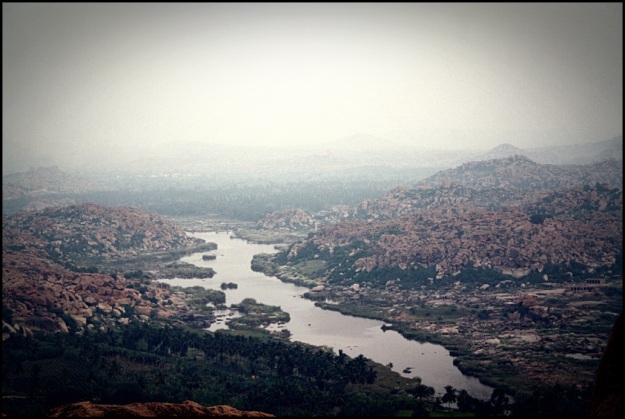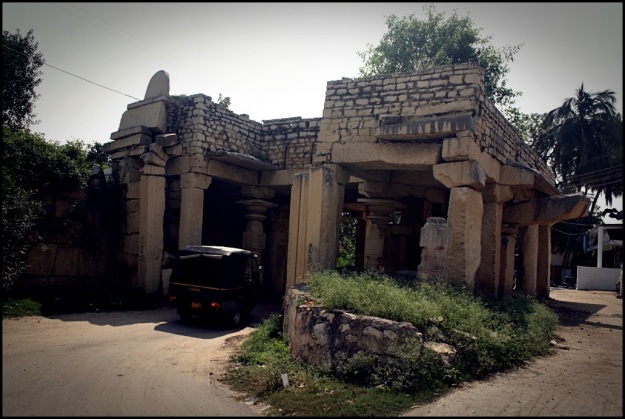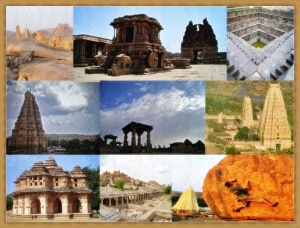I’ve probably written about three or four posts up until now on Hampi! A lot of these contain the historical relevance and the places that one can see and visit as travellers. A lot of times whenever I’ve been to Hampi, I’ve travelled alone and come back to write my experiences and my journey in the historical and archaeological realm of the empire. Some things that I always have cherished and realized about my relationship with this magnificent place was my Kannada roots and of course more recently my understanding of ancestral connections to this place through Late. Shri N.S Rajpurohit, my great grandfather who was part of excavations of the Talikota battlefield, the place where the Vijayanagara empire marked its death.
This time around, during Diwali, with a couple of old friends and a few new ones, we decided to set foot in the Vijayanagara Kingdom… It was quite a bunch of us friends. Some writers, thinkers, some travelers like me, some who were just like me fascinated with Hindu mythology and its symbolical association with historic cultures especially here. So this blog will be more about the journey and some photographs which embellished quite a memory on this entire trip, making it truly special for reminiscing old friendship while building new ones and some very special ones too.
Our first day began when we left Mumbai in a bus to Hospet. We had decided to stay at Hampi Gowri guest house this time around. This is across the Tungabhadra river on the Anjaneya mountain side. From the minute I had started speaking to Mr. Srinivas, my namesake, I had decided to go and stay there. The very helpful and polite manner that he spoke on the phone sounding very helpful and accomodating was something that made me pick this venue in not more than a few minutes of speaking with him. He also offered to pick us up from a destination enroute Hospet, which is towards his side of the town. When we reached there we mostly freshened up and took a walk to the Sanapur Lake, which was nearby and pretty much chilled out. waiting for the day to get over, finish our wonderful home cooked dinner made by Mr. Srinivas’s wife and crash…
Second day began when we set off in our mini van to take the tour of the city. It was very well spent with a guided tour, by me of course 😉 visiting the ancient ruins of Hampi and the various places that we ended up taking great pictures and spending some good time talking about their historical and archaeological significance from the standpoint of ancient India. Our day mostly touring and grabbing a quick bite of Chitranna and some mirchi bhaji was very fruitful especially after witnessing the Stone Chariot, our last and the most infamous and quite enchanting monument in this UNESCO World Heritage site. After we returned, thanks to the wonderful arrangement of a camp fire and a barbequeue! A fitting day to a tiring and yet very fun day!
Third day was mostly chilled out. It began with a late rising in the morning and eating our breakfasts, finely cooked Idlis, very tasty and certainly ones that you could gulp down as many as you could and yet feel the craving for more. We had decided to relax a bit since the second day was quite tiring and hectic and probably start slowly to end the day by climbing the famous birthplace of Hanuman, the Anjaneya temple on top of the mountain. We started off by heading to boating point, to cross the river in the famous round small boat of sorts, the coracle or putti as it’s called in Kannada. This was something one of our friends, Rahul wanted to experience and I had to ensure it was done! And quite an experience it was, for me for the second time, but all the more fun especially with good friends around. We also recorded a video, which I’ll upload later! So after which, we visited the Virupaksha temple and returned to the other side to have our lunch and head towards the Laxmi temple and Anjaneya mountain. Climbing the mountain just about the time the sun was setting, was a great experience. Once out there, witnessing entire Hampi, filled with boulders and mountains as if God himself had thrown mountains from the skies was quite overwhelming. Sitting with close friends seeing the sun set, added a perspective to this. On our way back at the foothill of the mountains, we stopped by to drink some coconut water, which I’d say was one of the best out here in the entire trip. We also happened to meet some really down to earth, humble and truly loving family who ran that shop, Govindappa Cold drinks house. Govindappa, his wife and his daughter ran the place. They were very hospitable, friendly, in fact really good people who offered us some bananas also for free. They were decorating the place as the next day was Diwali and we helped them out in some ideas. They really enjoyed it and thanked us as well. It was quite fun hanging out there as it gave us another perspective of how life is. How people like them still exist and how life is more than the materialistic living that most of us pursue out in big cities like Mumbai… Such was the ending to our 3rd day at Hampi. Surreal but true.
With all this amazing experience over a period of 3 days of staying in Hampi, gave us a lot of time as well. A lot of time to talk amongst each other and get to know each other more. A time to share stories of their own, anecdotes from their lives or the books that they read, was certainly an experience that we all enjoyed thoroughly. Some special moments, some fun, a lot of PJs being cracked, and some profound wisdom and knowledge shared amongst all of us friends. It was something that made the trip even more memorable. It gave us time to introspect on our own life and share some of those with each other to learn something remarkable about each other. Our final day was going to be the one where we explored some of the Anjaneya side of Hampi. We decided to rent mopeds, from Mr. Srinivas. They were reasonably priced as well! We set forth towards Anegundi, the old capital of Hampi. On our way back we stopped by at a place nearby the road. There were open fields staring across the horizon for acres and acres of land. Deepika my friend, had suggested that we go walk in the fields. Quite a good idea, I wondered to myself and decided to stop by. We asked a guy who was sitting near the field, he said it wasn’t his, but he told us to go ahead and take a look and that no one would mind. He had a smile on his face and was very happy that we wanted to explore these beautiful fields within his lands. And so we went, played around with the crops in the field, took some good DP worthy pics and went back on our bikes to go towards the other side of the river to explore the Monolithic bull area and probably do some last minute shopping. While the last minute shopping didn’t happen, we had quite a time in yeilding our mopeds on to a motorboat and taking it to and fro. But we managed to catch some really stumptous meal at Geeta River View…
With heavy hearts we bid goodbye to the Kingdom of Vijayanagara as the first day of Diwali came to an end with the brigh orange sun which we could see on our drive back to Hospet. It was an end to this trip, but a beginning of an alliance of a group that is going for some more travels of this sort and of course raring to come back to this beautiful ruins of Hampi…
Day 2
Day 3
Day 4
Picture Courtesy: Deepika Gumaste, Uday Mane, Niha Khan, Rahul Wakude & Melanie Joe 🙂 Thanks guys for the clicks….
Thanks to Mr. Srinivas for his hospitality and kindness. His wife for the awesome food, and to Harsha his son who served us and helped us out very diligently. I’d reccomend this place as a must stay and next time I’m down there, it’s going to be the place to stay 🙂
Contact details: www.hampigowri.com







































































